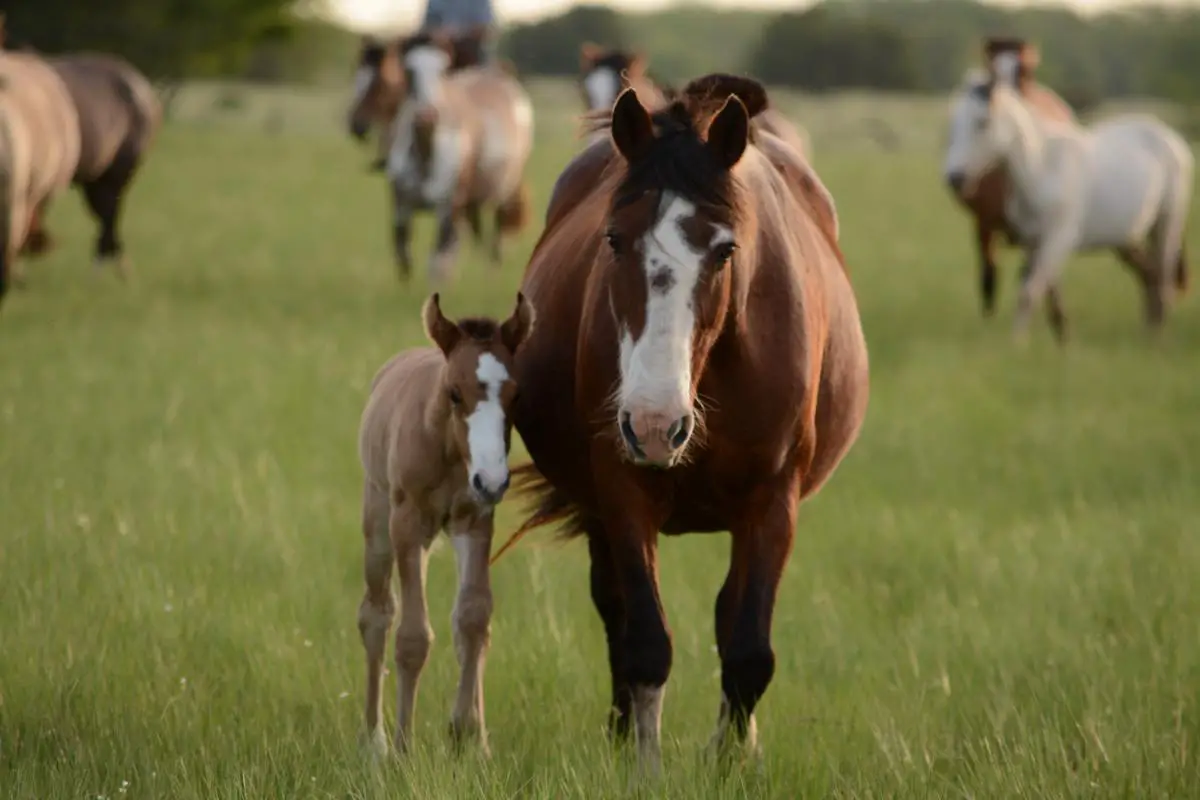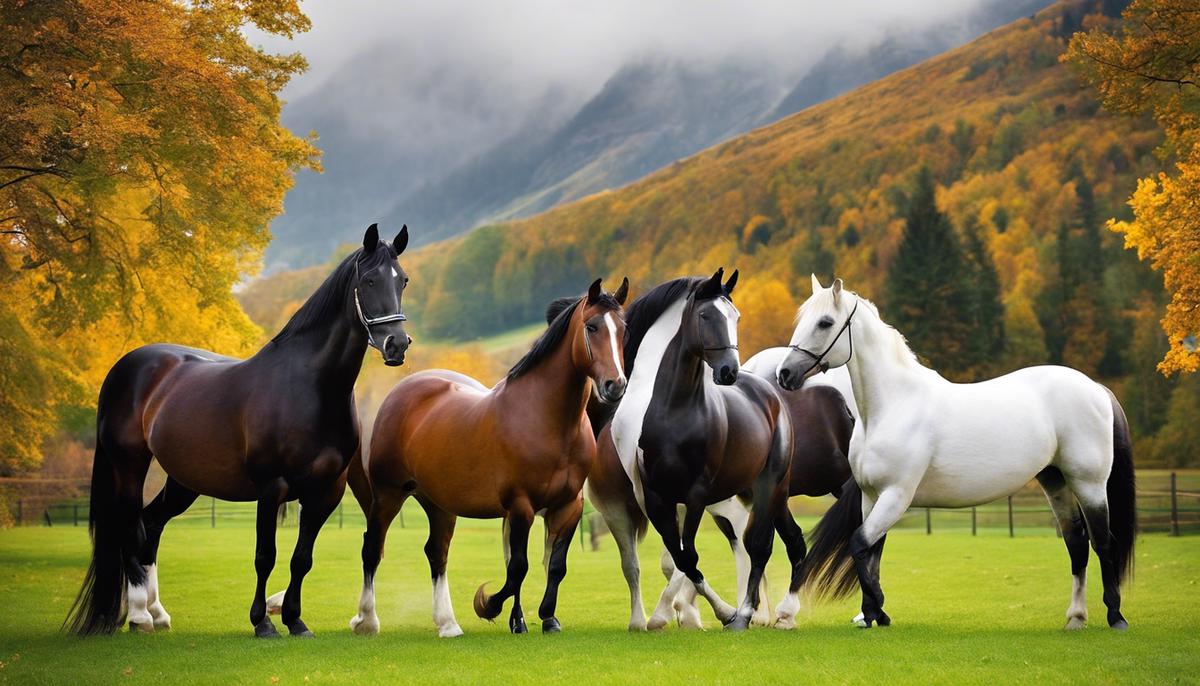From the serene landscapes of Switzerland, emanates an equine heritage as rich and diverse as the people who call this country home. Delving into the world of Swiss horses is akin to stepping into a captivating tale of history, culture, and distinctive uniqueness. The horses that hail from this region are more than mere mounts; they are the living embodiment of Swiss individuality, character, and resilience. In this exploration, we touch on the prominent Swiss horse breeds, dive into the intriguing emergence of the Swiss Warmblood, discuss the nuances of caring for these breeds, and take a look at their impact on the global stage of equestrian competition.
Table of Contents (Horspedia)
Prominent Swiss Horse Breeds
Galloping Through Switzerland: A Deep Dive into the Most Popular Horse Breeds
Are you a horse enthusiast harboring an unbridled interest in Switzerland’s most admired equine breeds? Or perhaps, you are simply intrigued by these majestic creatures and their place in Swiss culture. Either way, saddle up as we explore the most popular horse breeds in Switzerland and the unique traits that make them stand out!
First on the list is the iconic Freiberger. Known as the last genuine Swiss horse breed, the Freiberger is beloved and cherished as a living heritage. These horses score high for their compact size, sturdy physique, and docile nature, making them incredibly versatile. You’ll find them in various roles, from agricultural work to pleasure riding and even competitive events. Their steady trot and balanced canter make them one of the most sought-after breeds in Switzerland.
The Swiss Warmblood, or Schweizer Warmblut, undoubtedly deserves a mention. These horses are known for their athleticism and endurance, primarily bred for dressage and jumping disciplines. With their unquestionable elegance, power, and exceptional trainability, it’s no wonder they are a top choice for competitive equestarians throughout the country.
The beautifully rugged Haflinger breed has also found a solid footing in Switzerland. Named after the South Tyrolean village of Hafling, these chestnut beauties boast an unmatched combination of strength, endurance, and tranquility. They traverse Switzerland’s diverse terrains with unmatched ease, making them excellent choices for mountain trekking and pleasure riding. A Haflinger’s distinct flaxen mane and tail paired with steadfast resilience are a testament to the intimate relationship between the Swiss and their horses.
Further worth of consideration is the Swiss Draft Horse, the heavy lifter of the Swiss equestine line up. These formidable creatures offer an impressive display of muscle and might, utilized primarily for heavy draft and farm work. The Swiss Draft Horse showcases a proud lineage tracing back to the ancient Ardennes horse, reflecting an age-old tradition of equine prowess and labor in Switzerland.
Last but not least, the illustrious Rhaetian Horse, also known as the Ratische Kaltblut, comfortably settles in the Swiss equine scene. Despite being relatively rare, their hardiness, stamina, and extraordinary draft capabilities make them a unique and worthy addition to our list.
As we journey through this equine kaleidoscope, it becomes evident that each Swiss horse breed encapsulates an essential piece of the country’s identity, contributing to the diverse tapestry of Switzerland’s rich horse culture. From the humble Freiberger grazing in the pastures to the gallant Swiss Warmblood gliding in dressage arenas, these horse breeds unveiling their distinctive traits and abilities draws a fascinating equilibrium between tradition, functionality, and passion that fuels Swiss horsemanship.

The Swiss Warmblood’s Rise to Prominence
Stepping into the light more recently is the extraordinary Swiss Warmblood, a breed that’s rapidly catching the attention of horse enthusiasts around the globe. With its paddock roots in the spectacular Swiss landscape, you already know it has something special. Let’s delve into what makes the Swiss Warmblood tick and how it’s inevitably reshaping Switzerland’s equestrian panorama.
The Swiss Warmblood’s ascendance cannot be pinned simply to its physical elegance and prowess; it goes far beyond. Its gradual rise has much to do with the sterling combination of amicability, agility, and durability. Yes, this breed brings the perfect cocktail of personality, athletic potential, and resilience to the table. The Swiss Warmblood, in its essence, embodies qualities that make it adaptable to varied equestrian disciplines.
Interestingly, Swiss Warmbloods are not just ‘pretty faces.’ They’ve got substance, too! Estimated to have appeared on the Swiss equestrian scene around the 20th century through selective cross-breeding with other European warmbloods, these horses have been intentionally bred for sport purposes. Selective breeding has been a game-changer, enhancing their traits over generations, making them ideal companions for sports like eventing and show jumping, setting the stage for their popularity in the equestrian industry.
Despite their relatively recent emergence, Swiss Warmbloods have managed to influence Swiss horsemanship notably. Unlike some Swiss breeds that have traditionally contributed to farming and heavy labor, Swiss Warmbloods are carving out a distinct niche in sport and competition. There’s a shift happening here. It’s pulling focus away from labor-centric equine roles towards equestrian sports, creating an exciting new dynamic in Swiss horse culture.
In Switzerland, horsemanship isn’t merely about riding; it’s a lifestyle, a reflection of cultural identity. It’s where tradition weaves seamlessly with innovation, and the Swiss Warmblood is becoming an influential thread in this tapestry. Its prominence has prompted a shift in training focuses, with coaches developing programs better suited to nurture the warmbloods’ innate athleticism, testament to the breed’s forceful impact on the Swiss equestrian milieu.
Let’s be honest; Swiss Warmbloods have flair—their innate grace and agility graced dressage arenas, forcing both enthusiasts and breeders to take note. Their stunning high knee action, coupled with a powerful hindquarters’ push, has made the Swiss Warmblood an appealing choice for dressage. It’s this breed that’s putting Switzerland on the international dressage map – a testament to their escalating influence on global equestrian stage.
Regarded as versatile athletes, these horses are also making waves in the arena of show jumping. Their agility and power essentially lend themselves to be top contenders, often outperforming other breeds. The Swiss Warmblood’s increasing prominence in high-level competition has sparked interest among international breeders and riders, seeking to leverage this Swiss secret for success in their ventures. But be aware, the world has taken notice, and the Swiss Warmblood’s secret might not stay so for much longer!
Cultivating a hobby, especially one ingrained in cultural fabric as horse-keeping in Switzerland, isn’t a matter to be taken lightly. It’s a journey of learning, understanding, and embracing the changes along the way. The Swiss Warmblood, in all its glory, is certainly serving as a fascinating curveball, reshaping the contours of Swiss horsemanship and captivating hearts globally. In the world of equestrian evolution, the Swiss Warmblood indeed stands as a beacon of vibrant change.

Photo by sool_lorieto on Unsplash
Care and Keeping of Swiss Horse Breeds
Beyond the broad roles and characteristics of Swiss horse breeds that have been discussed earlier, it’s critical to further delve into how these magnificent species should be properly maintained and cared for. Essentially, their health, performance, and overall well-being, are not different from those of other breeds, but the precise practices and routines to keep them in optimal condition do bear distinctive aspects.
Swiss horse breeds, such as Freiberger, Swiss Warmblood, or Haflinger among others, are generally hardy and can withstand varying climate conditions. Still, a proper shelter plays a paramount role in a horse’s care routine. Providing a clean, dry, and well-ventilated stable for your Swiss horse breed can ensure they are protected from extreme weather and insect pests. Always remember that good air quality in the stable is vital as horses are prone to developing respiratory problems. Regular cleaning of stable, including proper manure management further contributes to maintaining a healthy environment.
Proper nutrition is another crucial aspect that shouldn’t be overlooked while caring for Swiss horse breeds. A balanced diet is necessary that aligns with the horse’s activity level, age, and individual health condition. Predominately, a Swiss horse’s diet should consist of high-quality forage. This can be supplemented with grains or concentrate feeds based on their energy needs. It’s advised to regularly consult with a veterinary nutritionist to suggest the best feeding regimen for your horse.
Swiss horse breeds are well-known for their remarkable endurance, which can be maintained through regular exercise. The intensity and duration of the exercise should be adjusted according to each horse’s requirements. For instance, a Freiberg used in farming would need different exercise than a Swiss Warmblood participating in dressage. Keep in mind: an exercised horse is a happy horse!
Regarding health care, Swiss horse breeds, like all breeds, need regular health check-ups and vaccinations. A regular worming routine is also an essential part of maintaining your horse’s health. Farrier care shouldn’t be overlooked; a horse’s hooves require regular examination and trimming to ensure they are in the best condition. In addition, timely dental check-ups would ensure a healthy feeding process and prevent other related issues.
One other key element is to acknowledge the inherent nature and characteristics of each Swiss breed. Providing time for the horse to be itself ensures mental well-being. Whether it is a Haflinger’s desire to trek, a Swiss Warmblood’s need to demonstrate its high knee actions, or a Swiss Draft Horse’s aptitude for heavy farm work, it’s essential to maintain a balance between their natural instincts and trained behaviors. In this context, gentle training techniques and a patient approach are recommended; they yield great results over time.
Therefore, maintaining and caring for Swiss horse breeds involve a comprehensive approach; understanding the individual breed, providing a suitable environment, excellent nutrition, regular exercise, and ensuring routine health care. Each horse is unique, let this uniqueness dictate its care and consider specifics when formulating a care routine. As a result, much of the charm of Swiss horse breeds lies in the experiences shared with them, and preserving these breeds in their best condition allows us to further appreciate their extraordinary qualities.

Swiss Horse Breeds in Competitive Equestrian
Swiss horse breeds, historically known for their labor-focused roles, have evolved over generations of selective breeding to become integral emblems of equestrian sports across the globe. Among these breeds, the Swiss Warmblood has rapidly gained international notoriety for its commendable attributes, making it a sought-after emblem in competitive equestrian circles.
Emerging from a blend of native and imported horse breeds, the Swiss Warmblood reflects a harmonious amalgamation of resilience, grace, and sociability. This agile horse breed is renowned for its robust constitution and friendly disposition, forging a unique identity that distinguishes it among other equine contemporaries.
The genesis of the Swiss Warmblood traces back to selective cross-breeding efforts focused on enhancing desired attributes for equestrian sports. This controlled breeding regimen has gradually transfigured a labor-centric breed into agile, sport-talented horses, emphasizing swiftness, and strength.
As this breed morphed from labor roles into more sport-centric purposes, the horsemanship practices within Switzerland also evolved. The focus shifted from concocting a durable workhorse to fostering a nimble sport horse, capable of excelling in competitive events.
In particular, Swiss Warmbloods have soared in popularity in dressage circles, primarily for their grace, elevating knee action, and agility – attributes that lend themselves well to this cognitive, skill-based sport. Also, these horses have proven their versatility and raw power in show jumping events, another sphere where they have secured substantial accolades.
Such athletic prowess hasn’t escaped international notice, earning the Swiss Warmblood a desirable reputation among breeders and riders around the world. This growing global intrigue has notably influenced the breed’s upward trajectory on the international equestrian stage, contributing to the blossoming visibility of Swiss horsemanship practices.
Finally, the rise of the Swiss Warmblood in equestrian sports has not only impacted Swiss horsemanship but also the global equestrian community. Its distinctive characteristics, adaptive versatility, and sports-centric evolution have underscored its relevance in international equestrian circles, influencing breed preference and horsemanship styles worldwide.
However, nurturing these outstanding breeds to optimize their athletic prowess and ensure their well-being necessitates a comprehensive care strategy. Ensuring clean, well-ventilated stables is key to fostering optimal respiratory health. A balanced diet, tailored to each horse’s needs, promotes overall health and stamina. Regular exercise, health check-ups, a consistent worming routine, and meticulous hoof and dental care are also fundamental aspects of a comprehensive care regimen. Furthermore, each breed’s unique instincts and characteristics deserve acknowledgment and preservation through gentle training techniques and a patient approach.

Peeling back the layers of Swiss horse breeds leaves one with a profound appreciation for these majestic creatures, their depth of character, and the role they play across various avenues of life in Switzerland. Swiss horses’ impact extends beyond the borders of their homeland, with their prowess and elegance shining proudly in the world of competitive equestrian sports. The care these horses require reflects their noble stature and intrinsic value, with attention to detail and empathy creating the bedrock for positive and healthy interactions. Ultimately, the world of Swiss horses is a fascinating tableau of history, culture, sport, and companionship that continues to impress and inspire.

